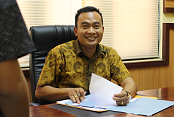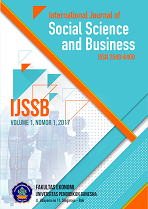Application of Biological Accounting for Wood Commodities at Perum Perhutani
DOI:
https://doi.org/10.23887/ijssb.v8i4.79267Keywords:
Biological Accounting, Wood Commodities, Forestry, Economic Value, Wood Resource ManagementAbstract
Wood commodities constitute the most significant income of Perum Perhutani; therefore, recording the value of inventory and sales must be done by applicable Financial Accounting Standards. This research aims to empirically prove the influence of disclosure, measurement, and disclosure dimensions on applying biological accounting for managing wood resources at Perum Perhutani. This research uses quantitative research methods with a case study approach. Data was obtained through interviews and focused group discussions with internal company parties regarding the application of biological accounting and analyzed using a structural equation model (SEM). The research results show that Perum Perhutani has made several efforts to apply biological accounting to manage wood resources. That is reflected in the implications of biological accounting policies that have been implemented well. The application of biological accounting at Perum Perhutani can help increase the efficiency of resource allocation, optimize the economic value of wood products, and support strategic decision-making that is oriented toward sustainability. From an environmental perspective, biological accounting provides advantages in identifying and reducing the negative impacts of timber forest exploitation activities.
References
Alexander, D., Bonaci, C.G., Mustata, R.V. 2012. Fair value measurement in financial reporting. Procedia Economics and Finance 3(12): 84-90.
Bahri, S.W. 2015. Evaluasi penilaian aset biologi dan pengaruhnya terhadap laporan keuangan. Jurnal Artikel Ilmiah Mahasiswa 4(1), 91-95.
Binkley, D.; R. Senock; S. Bird; T. Cole. 2003. Twenty Years of Stand Development in Pure and Mixed Stands of Eucalyptus Saligna and Nitrogen-fixing Falcataria Moluccana.Forest Ecology Management 182(1): 93–102.
Bohušová, H., Svoboda, P., Nerudová, D. 2012. Biological assets reporting: Is the increase in value caused by the biological transformation revenue Agricultural Economics (Czech Republic), 58(11): 520-532.
Baucher M., Halpin C, Conil MP, Boerjan W. 2003. Genetic engineering and impact on pulping.Critical Reviews in Biochemistry and Molecular Biology 38(4): 305-350.
Dwiprabowo, H., Suwarno, E. 2013. Komponen dan bobot dari kriteria dan indikator tata kelola perusahaan kehutanan. Jurnal Analisis Kebijakan Kehutanan 10(2): 118-132.
Hardiani, I., Chariri, A. 2014. Fair Value Measurement: Masalah Baru atau Solusi pada Pelaporan Keuangan (Studi Fenomenologi atas Pandangan Auditor). Diponegoro Journal of Accounting, 3(4): 378-389.
Hartati N Sri, Sudarmonowati E, Fatriasari W, Hermiati E, Dwianto W, Kaida R, Baba K, and Hayashi T. 2010. Wood Characteristic of Superior Sengon Collection and Prospect of Wood Properties Improvement through Genetic Engineering. World Research Journal 1(2):103-107
Huffman, A.A. (2013). Value Relevant Asset Measurement and Asset Use: Evidence from IAS. Vol. 41. USA: David Eccles School of Business, University of Utah. http://eifrs.ifrs.org. [4 Agustus 2023].
Karppinen, H. (2004). Biennial meeting of the Scandinavian Society of Forest Economics. Vantaa Matrix Modelling in Uneven-aged Forest Management. Berlin, Germany: Springer Science and Business Media. 40(1):67-80.
Lestari RME, Zarkasyi W, & Farida I. 2020. The Influence of Biological Asset Accounting Policies and Corporate Governance Practices on the Financial Performance: Moderating Role of Knowledge about Renewable Energy. International Journal of Energy Economics and Policy 10(5): 615-622.
Listriana RW, Rusli MS & Hermawati W. 2013. Pengembangan Strategic Business Unit Perhutani Unit III Jawa Barat dan Banten. Jurnal Manajemen & Agribisnis3(10):146-155.
Maruli, S., Farahmita, A. 2011. Analisis Penerapan Nilai Wajar dan Pendekatan Biaya Historis dalam Penilaian Aset Biologis di Perusahaan Pertanian. Jurnal Akuntansi Asia Pasifik dan Keuangan 1(2):133-149.
Rebitzer G, Ekvall T, Frischknecht R, Hunkeler D, Norris G, Rydberg T, Schmidt WP, Suh S, Weidema BP, Pennington DW. 2004. Life Cycle Assessment Environment. International30(1): 701–720.
Siregar U, Rachmi A, Massijaya M, Ishibashi N, & Ando K. (2007). Economic Analysis of Sengon (Paraserianthes falcataria) Community Forest Plantation, a Fast Growing Species in East Java, Indonesia. Forest Policy Economics 9(1): 822–829.
Sirkin, T. and Houten, M. 1994. The Cascade Chain: A Theory and a Tool for Achieving Resource Sustainability with Application for Product Design. Resource, Conservation Recycling 10(3): 213–276.
Wieruszewski M, Turbański W, Mydlarz K and Sydor M. 2023. Economic Efficiency of Pine Wood Processing in Furniture Production”. Forests MDPI Article 14(688):1-17
Zahra, I dan Saputra, MPA. 2022. Teak Wood Marketing Mix contributes to communities around the forest area at Perum Perhutani KPH Tasikmalaya. International Journal of Global Operations Research 3(1): 22-30.
Zerlinda W, Purnamawati I, & Sayekti Y. 2020. Analisis Perlakuan Akuntansi Aset Biologis pada Perum Perhutani KPH Jember. e-Journal Ekonomi Bisnis dan Akuntansi 7(2): 110-113.
Downloads
Published
How to Cite
Issue
Section
License
Copyright (c) 2024 Rochman Marota, Retno Martanti Endah Lestari, Razana Juhaida Johari

This work is licensed under a Creative Commons Attribution-ShareAlike 4.0 International License.










